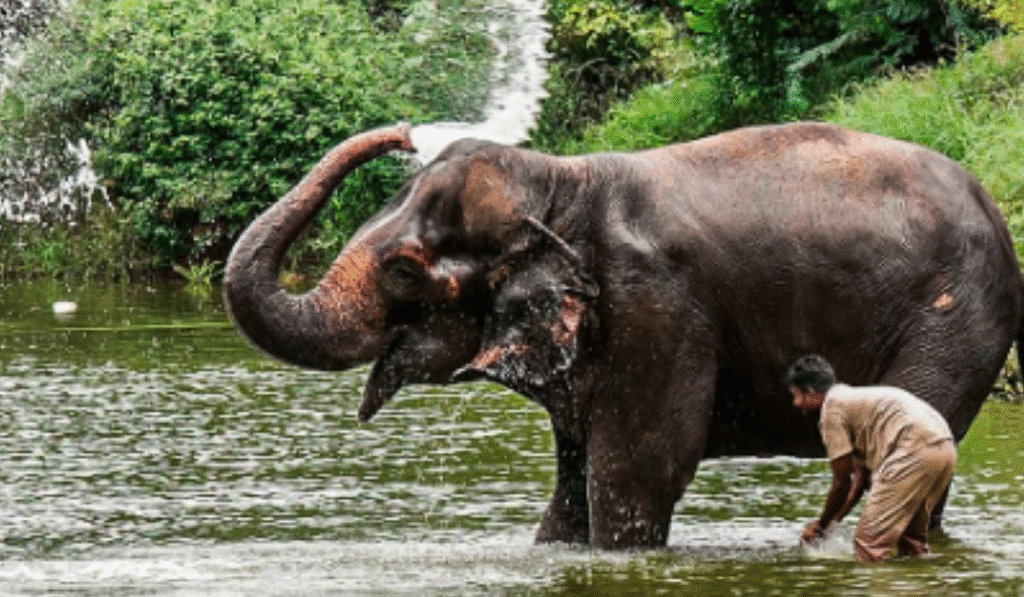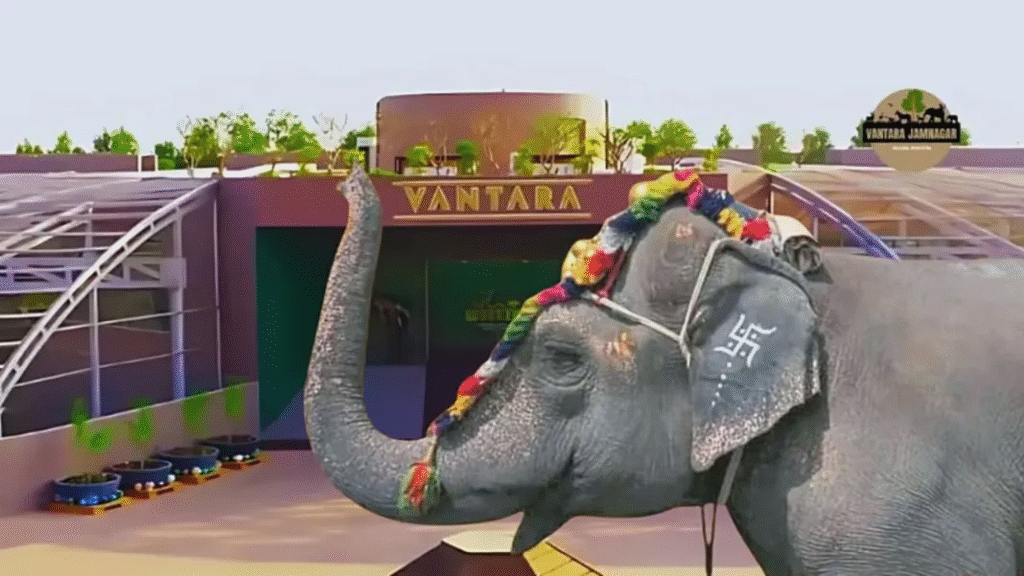In recent days, the story of Mahadevi, also known as Madhuri, an elephant who spent decades in captivity, has stirred the hearts of thousands across India. Her journey from being shackled in chains, bound by rituals and emotional manipulation, to finally being rescued represents not just the plight of a single animal, but also a mirror to our collective morality, tradition, and compassion.
A Sacred Bond or a Silent Prison?

For over 30 years, Mahadevi was kept at a private premise in Jamnagar, Gujarat, reportedly under the watch and protection of a prominent temple trust closely associated with the Ambani family. Locals claim that she wasn’t just an elephant, she was a deity’s vahana, a sacred being whose presence was considered essential for performing specific temple rituals. As per local belief, the deity would not accept offerings or rituals in her absence.
Over time, Mahadevi became a central figure in many spiritual ceremonies. People would queue up to take her blessings. Children grew up believing she was divine. But behind the grand image lay a disturbing reality: she was kept chained for most of her life, with little access to freedom, space, or interaction with her kind.
Photos and videos shared online in July 2025 showed the elephant with visible wounds on her legs due to the chains, signs of stress, and a lack of proper veterinary care. For animal rights activists and empathetic citizens, it was a gut-wrenching sight.
Why Was She Not Rescued Earlier?

That question haunted many. Elephants are protected under the Wildlife Protection Act of India and are classified as Schedule I animals, meaning they deserve the highest level of protection. Keeping them captive without proper permits or transferring them across states without approval is illegal.
However, influential ownership and deep-rooted religious sentiments made it incredibly difficult for wildlife authorities to intervene.
Local sources suggest that multiple complaints have been filed over the years. Still, they were either buried under bureaucratic pressure or met with resistance from the temple authorities who claimed that Mahadevi was “emotionally attached” to the premises and would not survive elsewhere.
This narrative was maintained until animal rights groups, backed by viral social media outrage, finally pushed the system to act.
The Social Media Uproar That Changed Everything

The turning point came when an anonymous whistleblower shared videos of Mahadevi struggling to stand, her movements restricted by decades-old iron chains, and surrounded by concrete with no greenery in sight.
What began as a few concerned tweets soon became a massive campaign under hashtags like #FreeMahadevi, #JusticeForMadhuri, and #ElephantNotIdol. Celebrities, wildlife NGOs, and environmental influencers added their voices to the conversation. Netizens drew comparisons between Mahadevi and other elephants like Lakshmi and Joymala, who faced similar fates before being rescued.
The outrage became too big to ignore. Eventually, the Forest Department, along with officials from the Wildlife SOS and the Animal Welfare Board of India, initiated the process of medical evaluation and relocation.
The Rescue: A Bittersweet Farewell

On July 26, 2025, wildlife authorities arrived in Jamnagar to rescue Mahadevi. It wasn’t a smooth process. Hundreds of local devotees protested, claiming that removing her would anger the gods. Emotional blackmail, legal threats, and false claims about her “health deteriorating if moved” were thrown around.
But the rescue team stood firm. They sedated her under veterinary supervision and loaded her onto a specially designed elephant ambulance. Photos from the day show Mahadevi looking confused, but calm as if she knew freedom was close.
She was transported to a wildlife care center in Mathura, run by Wildlife SOS, where she would undergo rehabilitation.
How Is Mahadevi (Madhuri) Now?
As of August 2025, Mahadevi is finally in a place where she can live as an elephant, not a symbol.

According to Wildlife SOS’s latest update, she is undergoing regular health checkups, receiving proper food and medication, and for the first time in decades, she can walk without chains.
Although she still shows signs of trauma like head swaying and hesitance toward humans, experts say this behavior is common among elephants who’ve endured prolonged captivity. Recovery will take time, but she is already showing signs of improvement.
Mahadevi is slowly being introduced to other rescued elephants. She touches trunks with them cautiously, testing bonds. Her days now involve mud baths, long walks in open fields, and medical massages for her aching joints.
Her caretakers say she enjoys splashing water, something she hadn’t been able to do for years. Most importantly, she’s surrounded by love, not the possessive kind disguised as devotion, but the liberating kind that seeks nothing in return.
From Idol to Individual: The Bigger Picture
Mahadevi’s story forces us to ask difficult questions:
- Why do we equate captivity with care when it comes to religious animals?
- Can devotion justify suffering?
- And should tradition override law and compassion?
India is home to over 2700 captive elephants, many of whom live in temples, private estates, or are used for begging and tourism. While elephants are revered in mythology, in reality, they are often stripped of their dignity and treated as property.
Activists argue that Mahadevi is just one name from a long list. Many others remain in chains emotionally or physically, waiting for someone to speak for them.
But Mahadevi’s case also gives hope. It proves that digital activism, combined with legal action, can bring change, even in places where power and faith seem impenetrable.
Final Words: Is She in a Better Place Now?
Yes. Undoubtedly.
Mahadevi, once confined within the walls of ritual, now roams open landscapes with other elephants by her side. While her scars (both mental and physical) may never fully vanish, she finally has the one thing she was denied for decades: freedom.
She no longer bows her head in rituals she never understood. She no longer wears the burden of someone else’s belief system. She is not a symbol. She is a living being, breathing, feeling, and finally free.





